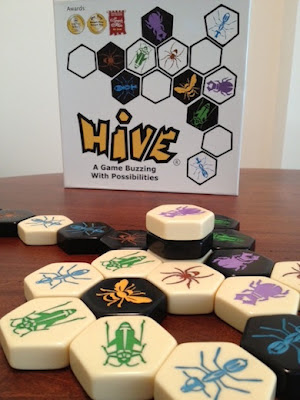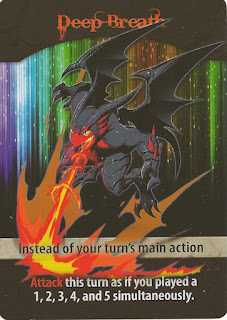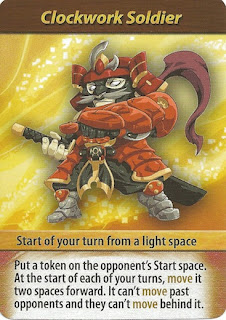One of Rio Grande Games' newest titles is Pantheon. Since I like so many of their other titles, I decided to try this one.
In Pantheon, the player represents a race of people that continues dying off and coming back to life. Or something like this - I'm unclear on what exactly. Either way, the players are attempting to build monuments and win the favor of the gods, because ultimately, their dying and resurrecting people group wants one thing - victory points. Pantheon is played over 6 "epochs". In each epoch, a certain civilization (not one of the players) is in power - this determines where the "temple" (starting point for the epoch) is placed, and each civilization also has a special effect that immediately occurs. After this setup, player take turns selecting actions. One action is movement - the player can play any number of movement cards from his hand, and gets one bonus movement for selecting the action. All of the movement has to start from the temple, and while placing, the player can attempt to claim "booty" tokens or can place monuments. After the first player performs his movement, all other players can choose to move as well (or draw one card). The next action that a player can select is a buy action - this lets you unlock more feet and columns (for movement), place feet and columns, or buy and upgrade sacrifice tiles (which help with gaining the favor of a god). The final two actions are gaining the favor of a god, or drawing three cards. The epoch continues until all of the booty tokens or god tokens have been collected. Then, you select a new civilization and start over. Except for after the third and sixth epoch - on those, you score for monuments and minor gods. (And after the sixth epoch you also put the game away.)
The first thing that I will note about Pantheon isn't really a pro or con, just an observation. From what I have seen, there are really two main strategies in Pantheon - you can attempt to build a lot of columns (the more you have, the more points they are worth, and ideally you want to place all of them if you want to win), or you can attempt to buy sacrifice tiles in order to gain the favor of the gods. When you gain the favor of the gods, you do this with a combination of sacrifice cards in your hand and sacrifice tiles you have purchased. But, sacrifice tiles don't go away after you use them (whereas you discard the used sacrifice cards). So, later in the game, if a player has purchased higher level sacrifice tiles, he will be able to gain the favor of many of the gods without even needing to draw extra cards. This is an incredibly strong strategy, and initially I thought it was overpowered. However (finally getting to my observation), I think that a player really needs to choose one of these two strategies if he wants to win. There is no middle ground. If a player attempts to both build monuments and gain the favor of the gods, he will probably lose. The monument strategy is viable, because monuments become more valuable as you place more of them, so the difference between placing all of your monuments and placing all but one of your monuments changes the score from 48 points down to 33 points! (You will also want to place as many monuments as you can early so that you can score as much as possible in the scoring phase after the third epoch.) Also, the better your sacrifice tiles are, the more easily you will be able to claim god tiles. So, having mediocre sacrifice tiles will force you to continue drawing cards while the other player is completing his empire. Choose one strategy and stick with it!
 |
| Some feet and gods |
The next pro really helps make the monument placing strategy feasible. I like that the temple moves to a different location each round, and that there are far more monument sites on the board than monuments each player has available. When I first started playing, I was assuming that if I didn't place a monument in every spot available to me on any given round, then I wouldn't be able to place them all. However, as I kept playing, I realized something - there are 18 locations where you can build a monument, and each player only has 12 monuments. Plus, since each epoch causes the temple to be in a different part of the board (and since you pick up your feet after each epoch), you don't have to have a major infrastructure in order to place these columns. Each temple has at least three suitable monument locations that are fairly close to it (though you might have built on them on previous turns). So, if you successfully build monuments on the available spaces near you each round, then you are going to be able to score very well! (Though, you will have to find something else to do in the final rounds if you somehow manage to place three monuments every epoch for the first four epochs.)
However, though I thought that there were a lot of unique and fun things about Pantheon (I wasn't exhaustive on my pros), there were several drawbacks as well. First, I was a bit disappointed with the actual production quality of the game. Without trying, I can think of three different typos in the game instructions/components, and also one place where the wrong image was inserted. Things happen, and I understand that. However, the typos would have been easily caught by any spell checker ("popints"). Whereas, I play games enough that I understand that the hobby board game industry is very small and can't afford a lot of proofreaders and editors (and, for that matter, I periodically find typos and grammatical errors in published books as well), these kinds of things would prevent me from showing Pantheon to my non-gaming friends, as I wouldn't want them to think that the board games I play aren't high quality.
My next con (actually game related!) is that the end of the game feels very anti-climactic. At the beginning, players are doing a lot of work building up their empire, and each epoch will probably last a decent amount of time. However, towards the end of the game, the epoch might only last a few turns. If players have purchased high level sacrifice tiles, they will be able to gain god tiles without having to play any cards, and player using the monument strategy will either have a lot of feet unlocked (so that they are ready to place many of them on their turn), or might even be out of monuments to place by the last epoch (this happened to me once). I felt like the game should have been scaled more to have more activity in each epoch, instead of the last couple of epochs being glorified scoring rounds for the player collecting god tiles.
Overall, I give Pantheon an 8.0/10. It was a fun game, and I enjoyed my plays with it - honestly, I'd be up for playing it more. However, I don't know that it has the staying power of a lot of Rio Grande's other titles.
If you like Pantheon, you might also want to check out Babel, Caylus, and The Heavens of Olympus.
I would like to thank Rio Grande Games for providing me with a review copy of Pantheon.
















